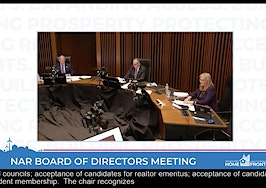The National Association of Realtors gained a record 80,000 members in 2020, according to the group’s annual Member Profile released on Thursday. A robust housing market and record unemployment pushed professionals to join the real estate industry, the Association said.

Dr. Jessica Lautz
“The COVID-19 pandemic and a booming housing market have led to a rising number of professionals entering the real estate business,” NAR Vice President of Demographics and Behavioral Insights Jessica Lautz said in a statement. “The National Association of Realtors membership grew to 1.48 million at the end of 2020, up from 1.4 million at the end of 2019.”
“Realtors continued to serve clients’ needs despite the challenges 2020 brought to the real estate market,” Lautz added. “Economic lockdowns and historically low inventory, coupled with surging homebuying demand, only showed the resilience of our members and industry.”
Reflecting the influx of new agents, the typical NAR member in 2020 had eight years of experience — down from nine years in 2019. Nearly a fourth of members had less than a year of experience and 79 percent said they plan to stay in the industry for at least two more years.
The majority of NAR members are licensed sales agents (68 percent), while the remaining members are either licensed brokers (20 percent) or licensed broker associates (14 percent) who work in residential real estate (73 percent).

The median gross income for NAR members declined 12.8 percent year over year to $43,330. The Realtors with the most experience ( >16 years) had a median gross income of $75,000, while nearly 60 percent of Realtors with the least experience (<2 years) had a median gross income of $10,000 or less.
In addition to declining gross incomes, 60 percent of NAR members said the continuing inventory crisis also resulted in reduced sales volume ($2.1 million vs. $2.3 million) and fewer transactions (10 vs. 12). Difficulty in finding the right property (11 percent), housing affordability (8 percent), and difficulty in obtaining mortgage finance (4 percent) also led to a decline in sales and transaction volume.
To keep transactions on track, Lautz said Realtors relied on technology more than ever during 2020. Texting was the top method of communication (93 percent), followed by phone calls (90 percent) and email (89 percent).

Members were most likely to use their multiple listing service (63 percent), electronic contract and forms (39 percent), e-signature (33 percent), contact management (32 percent) and document preparation (32 percent) software at least once a day, while they rarely used video (11 percent), property management (8 percent) or loan analysis (5 percent) tools.
“Realtors used emerging technologies in 2020 to bridge the gap when pandemic precautions were in place,” she said. “Members have now pivoted and embraced these tools to showcase listings and help buyers strategically find and secure the limited number of properties available.”













